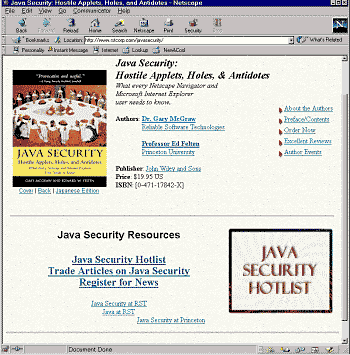
Networking has changed the face of computing. We once thought of computers as calculating machines, but now most people rightly view them primarily as communication tools. An Internet connection is as essential a part of today's computer as a disk drive. The move toward a globally networked world has been significantly furthered by Java.
Since its birth in the early 1970s as a 12-node network called the ARPANET,3 the Internet has exponentially exploded into a worldwide network that provides a central piece of the planet's information infrastructure. Figure 1.2 shows the growth pattern of the Internet from its humble 12-host beginning through today's some 30-million registered addresses.
Data is from Network Wizards (www.nw.com). The Internet continues to grow at an astounding rate. Connecting computers together in a network allows computer users to share data, programs, and each others' computational resources. Once a computer is put on a network, it is possible to access a remote machine in order to retrieve data or to use its CPU cycles and other resources. Along with this ability comes concern about security. Computer security specialists worry about issues such as:
The Internet, the world's largest network of machines, has encouraged research into these security issues. Mechanisms now in place go beyond simple password authentication, to firewalls and security checking tools such as SATAN, ISS, and Ballista. New ideas in computer security are constantly becoming available on the Net. Security approaches currently in preliminary use include encryption-based authentication, encrypted communications, and intrusion detection based on Artificial Intelligence (AI) [Hughes, 1995; Garfinkel and Spafford, 1996; Ghosh, 1998]. Computer security has recently matured into a substantial commercial enterprise as well. As in any new field, however, there is as much hype as there are barrels of snake oil. If it sounds too good to be true, it probably is. Buyer beware.
One of the driving forces behind the exponential growth of the Internet in the last several years has been the introduction of the World Wide Web. In 1992, Tim Berners-Lee, a British researcher at the CERN physics facility in Europe, invented the Web, a new way to use the Internet. His invention introduced hypertext markup language (HTML) and Web browsing to the world. In 1993, Marc Andreessen helped to write the Mosaic Web browser while affiliated with the National Center for Supercomputer Applications (NCSA). He later cofounded the company now known as Netscape Communications. Though it may be hard to believe, the Web is only a few years old. Before the invention of the Web, the Internet was almost exclusively text based. Researchers used it to transfer files to one another and to keep in touch via email. After the Web was invented, it suddenly became possible to see graphical pages sent across the Net by Web servers. These Web pages can include pictures, sound, video, and text, as well as hyperlinks to related pages. A Web browser provides an easy-to-use, intuitive interface for "surfing," or traveling around the Web, visiting other people's pages. Figure 1.3 shows how a typical Web page looks when viewed with the Netscape browser.
All current Web browsers include the capability of running mobile code automatically. Ease of use is partially responsible for the astonishing numbers of Web users, and perhaps for the sense of safety that most Web users seem to enjoy. In addition, creating Web pages is a relatively simple process. HTML editors like Netscape Navigator Gold and Microsoft FrontPage make the job especially easy. Given one of these editors and a Web server, you have all the pieces you need to create your own Web site. An alternative to using an HTML editor is to write HTML code directly. Either way, this snazzy HTML facade makes the Internet more attractive than ever. As shown in Figure 1.4, the Web has grown just as quickly as the Internet itself. The figure charts a conservative estimate of the number of Web servers on the Net. It is these servers that allow people to make Web pages available to everyone. The figure does not properly reflect the number of Web pages that are out there, which some people number in the hundreds of millions. Keep in mind that a server has the potential to serve hundreds or even thousands of pages for multiple users simultaneously.
HTML-based Web pages are certainly a big step up from using the obscure, text-based Unix incantations of ftp, news, gopher, wais, and telnet to get around on the Net; however, they also have a major drawback. Much like the page that you are reading now, Web pages are static. Wouldn't it be better to have interactive Web pages that dynamically change themselves according to feedback from a user? Wouldn't it be better to program your Web pages to accept input, compute results, and then display them? This sort of dynamic activity should ring a bell. After all, programming languages allow people to program machines to do just these sorts of things. Why not make a programming language for the Web? That is the essence of Java. Java is a full-featured programming language that allows programmers to compose executable content for the Web. The Java language is designed to be usable on all platforms so that code can move from one machine to another and still work, regardless of the kind of machine it ends up on. Cross-platform compatibility has always been a stumbling block in previous attempts to create programming languages for executable content. Mobile code can only truly be mobile if it can be executed on all platforms without porting and recompiling! In order to allow Java to run on a computer, the administrator must first install a Java Virtual Machine (JVM), or a browser that includes a Java VM. The JVM interprets Java instructions and translates them into machine-specific instructions. This allows Java to be run on many different types of machines.4 For old timers, the whole idea is reminiscent of P-code from the 1970s. Having a well-defined, platform-independent definition allows Java to get around problems that have plagued the C programming language, making C less platform independent than its designers intended. Unlike C programs, Java programs are not hampered by machine-dependent structures such as:
Java has upped the ante on the Web. The best Web pages now include Java applets that do everything from displaying selectable news tickers to providing front-end graphical user interfaces (GUIs) for internal databases. There are even some Web-based videogames written in Java. Java applets have become commonplace.
Java is by far the most popular implementation of Web-based mobile code. Lesser-known competitors include JavaScript, Safe-Tcl, Telescript, Word macros, Excel macros, ActiveX, and Postscript. Each of these systems raises its own security issues. Any document-embedded scripting language that can be transferred around the Net and run on different machines falls under the classification of executable content.5 Propelled by the marketing powers of Sun Microsystems and IBM, the Java wave is still building. Java avoids the interactive content limitations that were built in to forms and CGI (Common Gateway Interface) scripts.6 Java's power lies in the ability to program complete applications in a real programming language that can then be dynamically distributed and run by virtually any user over the Web.

Chapter... Preface -- 1 -- 2 -- 3 -- 4 -- 5 -- 6 -- 7 -- 8 -- 9 -- A -- B -- C -- Refs
Copyright ©1999 Gary McGraw and Edward Felten. |




